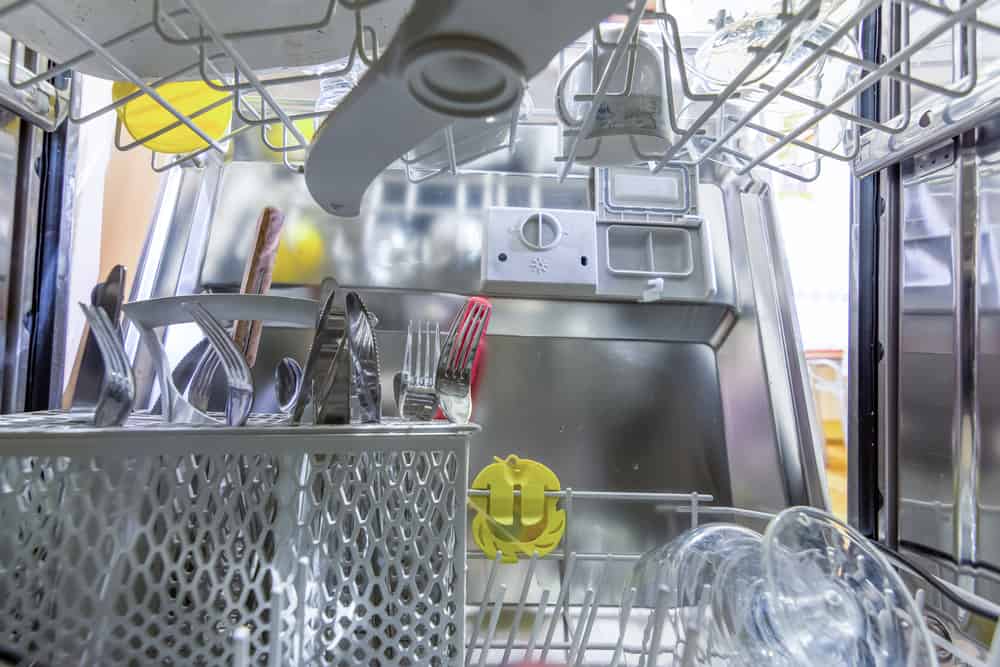Seriously, there’s nothing more aggravating than opening the dishwasher only to discover dirty dishes.
You have the expectation that these efficient appliances perform the tasks they’re designed to do. But honestly, people neglect their dishwasher’s interior.
Many people habitually overload trays, slap a tablet or pod into the receptacle, and wham! expect sparkling clean dishes.

Holding up a dirty glass that just was washed in a dishwasher
So what happens after prolonged neglect of a dishwasher? The results are dirty, poorly washed, and black spots on dishes.
While you may have invested in the top-of-the-line appliances like a KitchenAid dishwasher or high-performance unit like a Bosch, everyone is susceptible.
If this is happening to you, here’s how to tackle the problem of black spots on dishes.
When dishes come out dirty, obviously there is a problem. Even after running the extended cycle, you may find more black spots.
Open your dishwasher and examine the interior for potential culprits:
If the culprit isn’t apparent, you may have to dig deeper to find the clogged filter basket. If you don’t know where the dishwasher filter is, read on.
Before we tackle the dishwasher’s interior and start dismantling it, try a vinegar bath.
Dishwashers work hard. Don’t despair yet.
Vinegar bath method:
Vinegar is a powerful cleaning solution; however, it’s not a disinfectant like bleach and other harsh chemical cleaners.
If the problem persists, follow the next set of steps.
The first step is to take out the dish racks so that you can dive into the cavity of the dishwasher interior. While you got the racks in your hand, examine them for deterioration. Set them aside.

Analyzing the inside of your dishwasher for clues
Mold is unhealthy and can cause serious problems. In a survey conducted by a medical study, 62% of dishwashers contained some mold. Some even contained potentially harmful mold spores.
Mold can grow in 24-48 hours.
White or cleaning vinegar should tackle most mold. As a bonus, it will dissolve hard water stains. In some cases, a more powerful solution like bleach can destroy mold. However, never use bleach products on stainless steel models or parts. Opt for white vinegar instead.
Add baking soda to a regular maintenance cleaning cycle for an extra clean. Baking soda is effective for removing stains. It helps dissolve food particles. Using a vinegar solution creates a powerful foaming reaction that deodorizes and cleanses and removes mold.
Intense heat is part of the dishwashing cycle. Average dishwashers heat the water to 120 to 140 degrees Fahrenheit. Stainless steel interiors may get even hotter and reach 180 degrees Fahrenheit.
Water sanitizes dishes and utensils at those temperatures and helps dissolve food and grease.
If your dishwasher model can’t produce those high temperatures, try upping your hot water tank’s temperature.
Before starting your dishwasher, run the hot water in your kitchen sink to speed up the hot water reaching the dishwasher.
Plumbing pipes connect your dishwasher to your kitchen sink. If you have a garburator, try running it before starting the dishwasher to flush residual food waste down the line.
A dishwasher needs some tender care too. A monthly cleaning schedule will help prolong the unit’s lifespan. The real bonus is that the black spots on dishes in the dishwasher will vanish whenever you open that door.

With proper treatment and prevention, you won’t be dealing with dirty glasses anymore
Tips for preventing hard water and black spots:
